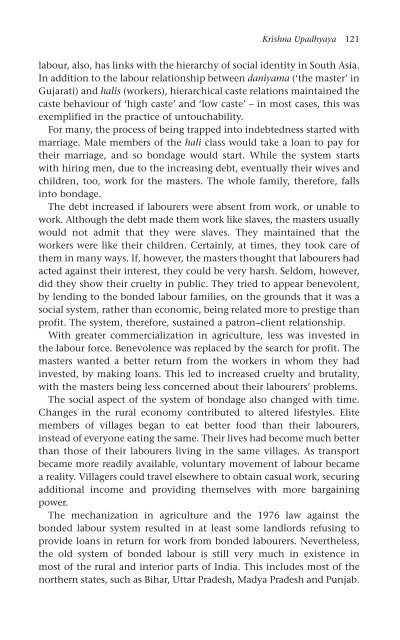3071-The political economy of new slavery
3071-The political economy of new slavery
3071-The political economy of new slavery
You also want an ePaper? Increase the reach of your titles
YUMPU automatically turns print PDFs into web optimized ePapers that Google loves.
Krishna Upadhyaya 121<br />
labour, also, has links with the hierarchy <strong>of</strong> social identity in South Asia.<br />
In addition to the labour relationship between daniyama (‘the master’ in<br />
Gujarati) and halis (workers), hierarchical caste relations maintained the<br />
caste behaviour <strong>of</strong> ‘high caste’ and ‘low caste’ – in most cases, this was<br />
exemplified in the practice <strong>of</strong> untouchability.<br />
For many, the process <strong>of</strong> being trapped into indebtedness started with<br />
marriage. Male members <strong>of</strong> the hali class would take a loan to pay for<br />
their marriage, and so bondage would start. While the system starts<br />
with hiring men, due to the increasing debt, eventually their wives and<br />
children, too, work for the masters. <strong>The</strong> whole family, therefore, falls<br />
into bondage.<br />
<strong>The</strong> debt increased if labourers were absent from work, or unable to<br />
work. Although the debt made them work like slaves, the masters usually<br />
would not admit that they were slaves. <strong>The</strong>y maintained that the<br />
workers were like their children. Certainly, at times, they took care <strong>of</strong><br />
them in many ways. If, however, the masters thought that labourers had<br />
acted against their interest, they could be very harsh. Seldom, however,<br />
did they show their cruelty in public. <strong>The</strong>y tried to appear benevolent,<br />
by lending to the bonded labour families, on the grounds that it was a<br />
social system, rather than economic, being related more to prestige than<br />
pr<strong>of</strong>it. <strong>The</strong> system, therefore, sustained a patron–client relationship.<br />
With greater commercialization in agriculture, less was invested in<br />
the labour force. Benevolence was replaced by the search for pr<strong>of</strong>it. <strong>The</strong><br />
masters wanted a better return from the workers in whom they had<br />
invested, by making loans. This led to increased cruelty and brutality,<br />
with the masters being less concerned about their labourers’ problems.<br />
<strong>The</strong> social aspect <strong>of</strong> the system <strong>of</strong> bondage also changed with time.<br />
Changes in the rural <strong>economy</strong> contributed to altered lifestyles. Elite<br />
members <strong>of</strong> villages began to eat better food than their labourers,<br />
instead <strong>of</strong> everyone eating the same. <strong>The</strong>ir lives had become much better<br />
than those <strong>of</strong> their labourers living in the same villages. As transport<br />
became more readily available, voluntary movement <strong>of</strong> labour became<br />
a reality. Villagers could travel elsewhere to obtain casual work, securing<br />
additional income and providing themselves with more bargaining<br />
power.<br />
<strong>The</strong> mechanization in agriculture and the 1976 law against the<br />
bonded labour system resulted in at least some landlords refusing to<br />
provide loans in return for work from bonded labourers. Nevertheless,<br />
the old system <strong>of</strong> bonded labour is still very much in existence in<br />
most <strong>of</strong> the rural and interior parts <strong>of</strong> India. This includes most <strong>of</strong> the<br />
northern states, such as Bihar, Uttar Pradesh, Madya Pradesh and Punjab.


